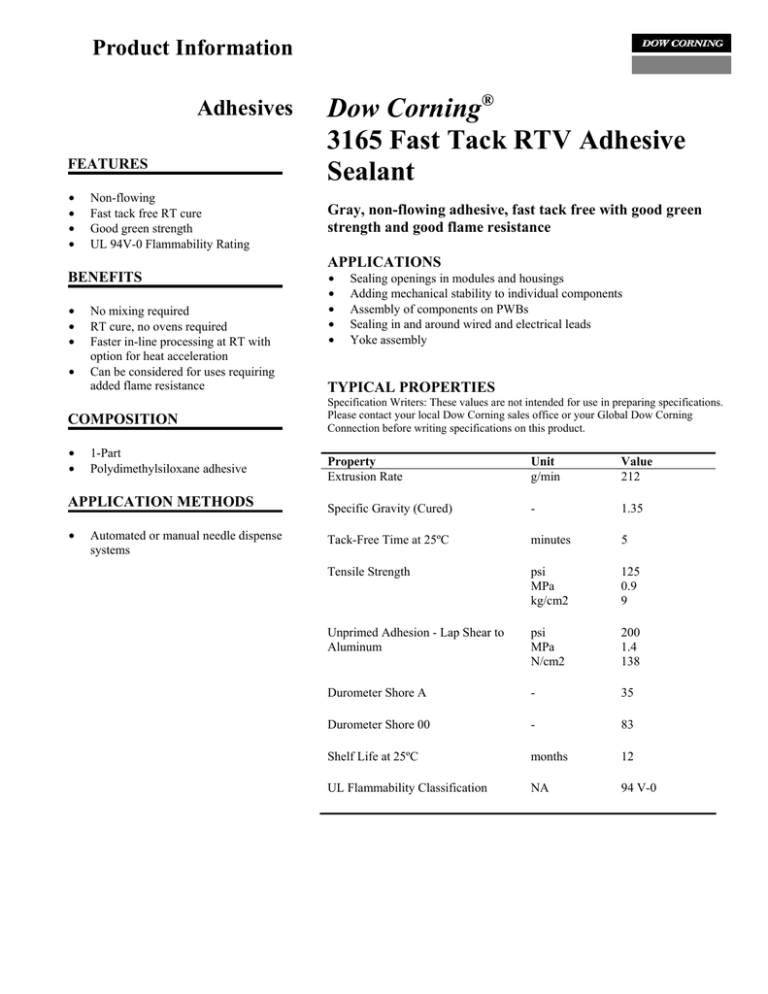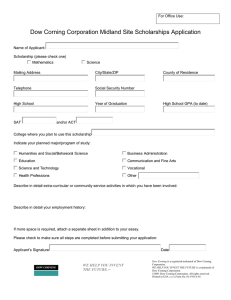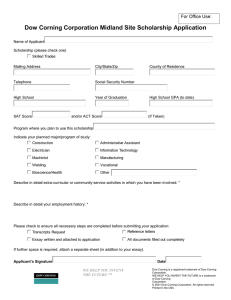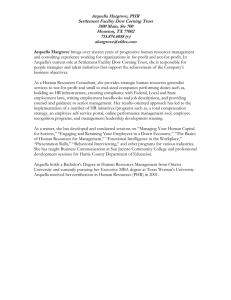
Product Information
Adhesives
FEATURES
•
•
•
•
Non-flowing
Fast tack free RT cure
Good green strength
UL 94V-0 Flammability Rating
Dow Corning®
3165 Fast Tack RTV Adhesive
Sealant
Gray, non-flowing adhesive, fast tack free with good green
strength and good flame resistance
APPLICATIONS
BENEFITS
•
•
•
•
No mixing required
RT cure, no ovens required
Faster in-line processing at RT with
option for heat acceleration
Can be considered for uses requiring
added flame resistance
COMPOSITION
•
•
1-Part
Polydimethylsiloxane adhesive
APPLICATION METHODS
•
Automated or manual needle dispense
systems
•
•
•
•
•
Sealing openings in modules and housings
Adding mechanical stability to individual components
Assembly of components on PWBs
Sealing in and around wired and electrical leads
Yoke assembly
TYPICAL PROPERTIES
Specification Writers: These values are not intended for use in preparing specifications.
Please contact your local Dow Corning sales office or your Global Dow Corning
Connection before writing specifications on this product.
Property
Extrusion Rate
Unit
g/min
Value
212
Specific Gravity (Cured)
-
1.35
Tack-Free Time at 25ºC
minutes
5
Tensile Strength
psi
MPa
kg/cm2
125
0.9
9
Unprimed Adhesion - Lap Shear to
Aluminum
psi
MPa
N/cm2
200
1.4
138
Durometer Shore A
-
35
Durometer Shore 00
-
83
Shelf Life at 25ºC
months
12
UL Flammability Classification
NA
94 V-0
DESCRIPTION
Dow Corning one-part moisture cure
adhesives are generally cured at room
temperature and in an environment of
30 to 80 percent relative humidity
eliminating the need for curing ovens
and the associated costs of energy and
capital. Greater than 90 percent of
full physical properties should be
attained within 24 to 72 hours and
varies according to product. Faster
manufacturing throughput can be
achieved since the adhesive and
component can be handled in much
shorter times of about 10 to 120
minutes, depending on the adhesive
selected and the amount applied.
These adhesives are not typically
used in highly confined spaces or
where a deep section cure is required
as they generally cure from the
exposed surface inward at a rate of
0.25 inch per seven days. Cure
progresses from the outer exposed
surface and is dependent on the
moisture in the air. Working time is
generally a few minutes to an hour
for these products until a surface skin
begins to form. Mild heat below 60°C
(140°F) may be used to increase
through-put by accelerating the cure.
Dow Corning silicone adhesives
retain their original physical and
electrical properties over a broad
range of operating conditions which
enhance the reliability of and service
life of electronic devices. The stable
chemistry and versatile processing
options of these adhesives offer
benefits for a variety of electronics
needs from increasing component
safety and reliability, reducing total
cost or increasing the performance
envelope of devices or modules.
Underwriters Laboratory (UL) 94
recognition is based on minimum
thickness requirements. Please
consult the UL Online Certifications
Directory for the most accurate
certification information.
PACKAGING
RTV Adhesives are typically
packaged in 100 ml syringes and 330
ml cartridges, 1 kg tubs and pails (18
- 25 kg). In general, Dow Corning
adhesives/sealants are supplied in
nominal 0.45-, 3.6-, 18- and 200-kg
(1-, 8-, 40- and 440-lb) containers,
net weight. Not all products may be
available in all packages and some
additional packages, such as a bladder
packs or tubes, may be available for
certain package sizes.
USABLE LIFE AND
STORAGE
For best results, Dow Corning RTV
adhesives should be stored at or
below the storage temperature listed
on the product label. Special
precautions must be taken to prevent
moisture from contacting these
materials. Containers should be kept
tightly closed with head or air space
minimized. Partially filled containers
should be purged with dry air or other
gases, such as nitrogen. Shelf life is
indicated by the “Use Before” date
found on the product label.
PREPARING SURFACES
All surfaces should be thoroughly
cleaned and/or degreased with Dow
Corning® brand OS Fluids, naphtha,
mineral spirits, methyl ethyl ketone
(MEK) or other suitable solvent.
Solvents such as acetone or isopropyl
alcohol (IPA) do not tend to remove
oils well, and any oils remaining on
the surface may interfere with
adhesion. Light surface abrasion is
recommended whenever possible,
because it promotes good cleaning
and increases the surface area for
bonding. A final surface wipe with
acetone or IPA is also useful. Some
cleaning techniques may provide
better results than others; users
should determine the best techniques
for their particular applications.
SUBSTRATE TESTING
Due to the wide variety of substrate
types and differences in substrate
surface conditions, general statements
on adhesion and bond strength are
impossible. To ensure maximum
bond strength on a particular
substrate, 100 percent cohesive
failure of the adhesive in a lap shear
or similar adhesive strength test is
desired. This ensures compatibility of
the adhesive with the substrate being
considered. Also, this test can be used
to determine minimum cure time or
can detect the presence of surface
contaminants such as mold release
agents, oils, greases and oxide films.
ADHESION
Dow Corning silicone adhesives are
specially formulated to provide
unprimed adhesion to many reactive
metals, ceramics and glass, as well as
to selected laminates, resins and
plastics. However, good adhesion
cannot be expected on non-reactive
metal substrates or non-reactive
plastic surfaces such as Teflon®,
polyethylene or polypropylene.
Special surface treatments such as
chemical etching or plasma treatment
can sometimes provide a reactive
surface and promote adhesion to
these types of substrates. Dow
Corning® brand Primers can be used
to increase the chemical activity on
difficult substrates. Poor adhesion
may be experienced on plastic or
rubber substrates that are highly
plasticized, because the mobile
plasticizers act as release agents.
Small-scale laboratory evaluation of
all substrates is recommended before
production trials are made.
USEFUL TEMPERATURE
RANGES
For most uses, silicone elastomers
should be operational over a
temperature range of -45 to 200°C (49 to 392°F) for long periods of time.
However, at both the low- and high
temperature ends of the spectrum,
behavior of the materials and
performance in particular applications
can become more complex and
require additional considerations. For
low-temperature performance,
thermal cycling to conditions such as
-55°C (-67°F) may be possible, but
performance should be verified for
your parts or assemblies. Factors that
may influence performance are
configuration and stress sensitivity of
components, cooling rates and hold
times, and prior temperature history.
At the high-temperature end, the
durability of the cured silicone
elastomer is time and temperature
dependent. As expected, the higher
the temperature, the shorter the time
the material will remain useable.
SOLVENT EXPOSURE
When liquid or vapor solvent or fuel
exposure can occur in an application,
the silicone adhesive discussed in this
brochure is intended only to survive
splash or intermittent exposures. It is
not suited for continuous solvent or
fuel exposure. Testing should be
done to confirm performance of the
adhesives under these conditions.
HANDLING
PRECAUTIONS
PRODUCT SAFETY
INFORMATION REQUIRED
FOR SAFE USE IS NOT
INCLUDED IN THIS
DOCUMENT. BEFORE
HANDLING, READ PRODUCT
AND MATERIAL SAFETY DATA
SHEETS AND CONTAINER
LABELS FOR SAFE USE,
PHYSICAL AND HEALTH
HAZARD INFORMATION. THE
MATERIAL SAFETY DATA
SHEET IS AVAILABLE ON THE
DOW CORNING WEBSITE AT
WWW.DOWCORNING.COM, OR
FROM YOUR DOW CORNING
REPRESENTATIVE, OR
DISTRIBUTOR, OR BY
CALLING YOUR GLOBAL DOW
CORNING CONNECTION.
2010, Month 03
Ref. No. 11-1810-01
HEALTH AND
ENVIRONMENTAL
INFORMATION
To support Customers in their
product safety needs, Dow Corning
has an extensive Product Stewardship
organization and a team of Product
Safety and Regulatory Compliance
(PS&RC) specialists available in each
area. For further information, please
see our website,
www.dowcorning.com or consult
your local Dow Corning
representative.
LIMITATIONS
This product is neither tested nor
represented as suitable for medical or
pharmaceutical uses.
LIMITED WARRANTY
INFORMATION PLEASE
READ CAREFULLY
specifications in effect at the time of
shipment. Your exclusive remedy for
breach of such warranty is limited to
refund of purchase price or
replacement of any product shown to
be other than as warranted.
DOW CORNING SPECIFICALLY
DISCLAIMS ANY OTHER
EXPRESS OR IMPLIED
WARRANTY OF FITNESS FOR
A PARTICULAR PURPOSE OR
MERCHANTABILITY.
DOW CORNING DISCLAIMS
LIABILITY FOR ANY
INCIDENTAL OR
CONSEQUENTIAL DAMAGES.
We help you invent the future. ™
dowcorning.com
The information contained herein is
offered in good faith and is believed
to be accurate. However, because
conditions and methods of use of our
products are beyond our control, this
information should not be used in
substitution for customer’s tests to
ensure that our products are safe,
effective, and fully satisfactory for
the intended end use. Suggestions of
use shall not be taken as inducements
to infringe any patent. Dow
Corning’s sole warranty is that our
products will meet the sales
Dow Corning is a trademark of Dow Corning Corporation.
We help you invent the future is a trademark of Dow Corning Corporation.
XIAMETER is a registered trademark of Dow Corning Corporation.
© 2010 Dow Corning Corporation. All rights reserved.




